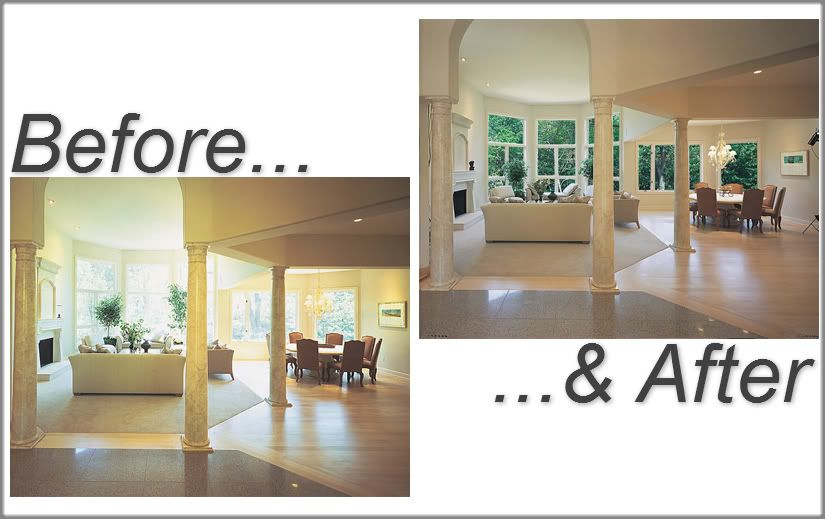Have you experienced the summer heat?
Consider combating the heat and high energy bills with window tinting. If you are considering window tinting in Medford, Oregon, B&C Sun Control Window Tinting really is your best bet. Call them today for a free estimate!
The following is a guest editorial from
Virginia L. Kubler:
As glass is increasingly used in American homes, more and more home owners are turning to professionally installed solar control window film to help guard against fading, to reduce the sun's glare and for energy savings.
Clearly, there is a conflict between a home owner's desire for a spacious, airy interior incorporating large expanses of glass and the ravages wrought by the sun. Furthermore, there is an energy price to pay. Heat passes readily through glass—approximately 50 percent of a home's utility bills are wasted by loss of heat and heat gain through untreated glass.
 Consumers have become increasingly aware of the sophisticated window films that are available and the attributes they offer. Window films are environmentally friendly. They save energy. They help protect furnishings and art from fading and
Consumers have become increasingly aware of the sophisticated window films that are available and the attributes they offer. Window films are environmentally friendly. They save energy. They help protect furnishings and art from fading andhelp eliminate glare and hot spots. Finally, they allow home owners to make optimum use of outdoor views afforded by modem spacious windows.
In today's business climate, as we approach the 21st century, there exists a strong, growing potential market for window coverings retailers and suppliers to increase business with a multifaceted solution for solar control problems.
High-tech Film
Solar control window film should not be confused with the automotive black tinting film of the past. Today's sophisticated window film provides an efficient as well as economical solution to solar problems. The product is a high-tech laminate of polyester and metalized coatings bonded by distortion-free adhesives. It is designed to deal with the individual electromagnetic wave-lengths of the sun's energy in such a manner as to curb heat passing through the glass (infrared), control light transmission and virtually eliminate ultraviolet radiation, the main cause of fading.
The amount of energy savings achieved per household depends on the window film used, the building's construction and the climate in which the building is located. For example, there are wind lav films available that reject from 35 percent of the solar energy for a neutral film that is virtually impossible to detect to 79 percent for a highly reflective film. And there is a wide range of films available today to serve residential and commercial needs for energy savings, aesthetics and security.
New energy saving window Sims have been introduced recently. They are known as Low-E films. Low-E stands for low emissivity, a measurement of a surface's ability to absorb heat. The lower the emissivity, the less heat is absorbed by the glass the more room heat is reflected back into the home. For window films, the lower the emissivity rating, the better. For example, a window film with an emissivity rating of 0.45 would reflect back 55 percent of the room heat that would be lost through untreated glass. An emissivity rating of 0.36 means 64 percent of the room heat would be retained.
Additionally, today's high-tech window films will reject exterior solar energy that reaches windows—most of which is sensed as heat—thus yielding substantial savings on air conditioning in the warm months of the year.
Windows fitted with a high-quality, high-tech, Low-E window film should provide excellent visibility, transmitting 49 percent of all visible light, and offer an economical alternative to purchasing Low-E glass and replacing a standard window.
Challenges
One of the challenges facing home owners in a warm, sunny climate is to control the sun's energy during the day and to preserve privacy as well as night-time views. Many high solar rejection window films actually prevent people inside a home from seeing out but allow those outside to see in. New dual reflective films, however, have a high solar rejection rate, up to 65 percent for Vista Luminance by CPFilms Inc., and yet provide clear visibility from the inside day or night.
These films are constructed with an exclusive, clear, distortion-free adhesive system and a special scratch-free face coating that allows for easy maintenance using standard window cleaning products. They provide an added safety benefit by forming a shield across the glass on which they are fitted. If the glass were to be broken, must of the fragments would be held in place.
Before & After Window Tinting

As a retrofit item, window film is applied on the inside of windows and is compatible with either single or double-pane (thermal) glass of any shape or size normally found in today's homes. Window films often are used with decorative window treatments as a protective complement for draperies, curtains, blinds, shades and even awnings.
The installation of window film is critically important to aesthetics and longevity The best films will be marketed through highly trained specially selected dealers who are responsible for installation. These dealers need to be trained to help the home owner match the choice of film to the domestic challenge to be faced. Professional installation is quick, without mess and without the need to interrupt normal day-to-day activities.


